ECU FORD F650/750 2024 Owners Manual
[x] Cancel search | Manufacturer: FORD, Model Year: 2024, Model line: F650/750, Model: FORD F650/750 2024Pages: 386, PDF Size: 8.7 MB
Page 5 of 386

Introduction
About This Manual..........................................7
Data Recording.................................................11
Perchlorate.......................................................15
Ford Credit........................................................15
Replacement Parts Recommendation............................................................................15
Special Notices...............................................16
Mobile Communications Equipment............................................................................17
Export Unique Options................................18
Federal Highway AdministrationRegulation....................................................18
Entering, Exiting or Climbing on ThisVehicle............................................................18
Symbols Glossary
Symbols Used on Your Vehicle.................19
Environment
Protecting the Environment......................22
Noise Pollution Control...............................22
At a Glance
Instrument Panel...........................................24
Child Safety
General Information.....................................25
Installing Child Restraints...........................27
Booster Seats.................................................33
Child Restraint Positioning........................35
Child Safety Locks........................................36
Seatbelts
Principle of Operation.................................38
Fastening the Seatbelts.............................39
Seatbelt Height Adjustment.....................42
Seatbelt Warning Lamp and IndicatorChime............................................................43
Seatbelt Reminder.......................................43
Child Restraint and SeatbeltMaintenance...............................................45
Seatbelt Extensions.....................................45
Keys and Remote Controls
General Information on RadioFrequencies................................................46
Remote Control..............................................47
Replacing a Lost Key or Remote Control..........................................................................48
Doors and Locks
Locking and Unlocking...............................49
Security
Passive Anti-Theft System.........................51
Steering Wheel
Adjusting the Steering Wheel...................52
Cruise Control - Vehicles With: AdaptiveCruise Control.............................................52
Cruise Control - Vehicles With: CruiseControl...........................................................52
Information Display Control......................53
Horn....................................................................53
Wipers and Washers
Windshield Wipers........................................54
Windshield Washers....................................54
Lighting
General Information.....................................55
Lighting Control.............................................55
Autolamps.......................................................56
Instrument Lighting Dimmer....................56
Headlamp Exit Delay...................................56
Daytime Running Lamps - Vehicles With:Daytime Running Lamps (DRL)..........57
Daytime Running Lamps - Vehicles With:Configurable Daytime Running Lamps...........................................................................57
1
2024 F-650/750 (TBC) , enUSA, Edition date: 202210, First-PrintingTable of Contents
Page 22 of 386
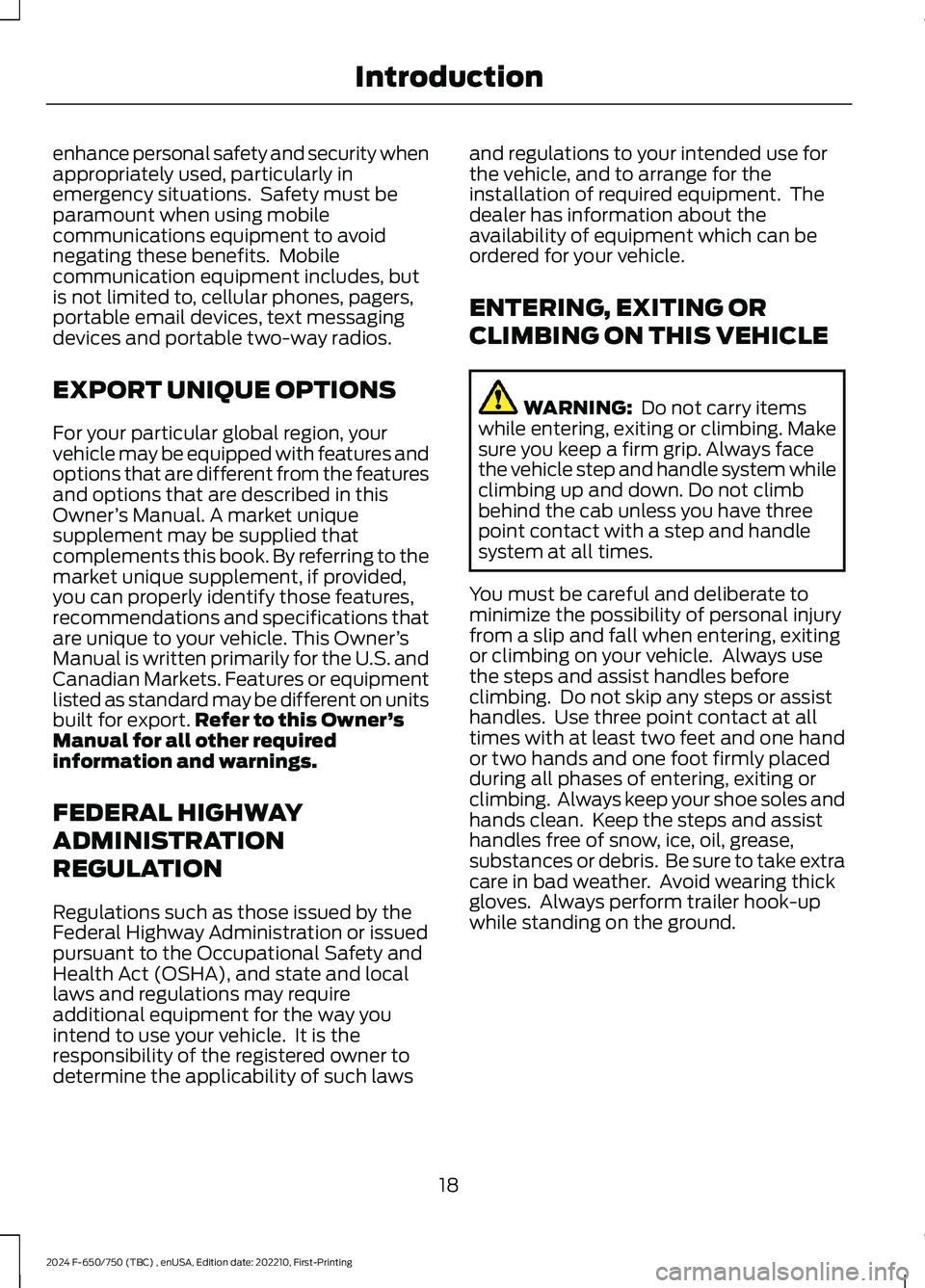
enhance personal safety and security whenappropriately used, particularly inemergency situations. Safety must beparamount when using mobilecommunications equipment to avoidnegating these benefits. Mobilecommunication equipment includes, butis not limited to, cellular phones, pagers,portable email devices, text messagingdevices and portable two-way radios.
EXPORT UNIQUE OPTIONS
For your particular global region, yourvehicle may be equipped with features andoptions that are different from the featuresand options that are described in thisOwner’s Manual. A market uniquesupplement may be supplied thatcomplements this book. By referring to themarket unique supplement, if provided,you can properly identify those features,recommendations and specifications thatare unique to your vehicle. This Owner’sManual is written primarily for the U.S. andCanadian Markets. Features or equipmentlisted as standard may be different on unitsbuilt for export.Refer to this Owner’sManual for all other requiredinformation and warnings.
FEDERAL HIGHWAY
ADMINISTRATION
REGULATION
Regulations such as those issued by theFederal Highway Administration or issuedpursuant to the Occupational Safety andHealth Act (OSHA), and state and locallaws and regulations may requireadditional equipment for the way youintend to use your vehicle. It is theresponsibility of the registered owner todetermine the applicability of such laws
and regulations to your intended use forthe vehicle, and to arrange for theinstallation of required equipment. Thedealer has information about theavailability of equipment which can beordered for your vehicle.
ENTERING, EXITING OR
CLIMBING ON THIS VEHICLE
WARNING: Do not carry itemswhile entering, exiting or climbing. Makesure you keep a firm grip. Always facethe vehicle step and handle system whileclimbing up and down. Do not climbbehind the cab unless you have threepoint contact with a step and handlesystem at all times.
You must be careful and deliberate tominimize the possibility of personal injuryfrom a slip and fall when entering, exitingor climbing on your vehicle. Always usethe steps and assist handles beforeclimbing. Do not skip any steps or assisthandles. Use three point contact at alltimes with at least two feet and one handor two hands and one foot firmly placedduring all phases of entering, exiting orclimbing. Always keep your shoe soles andhands clean. Keep the steps and assisthandles free of snow, ice, oil, grease,substances or debris. Be sure to take extracare in bad weather. Avoid wearing thickgloves. Always perform trailer hook-upwhile standing on the ground.
18
2024 F-650/750 (TBC) , enUSA, Edition date: 202210, First-PrintingIntroduction
Page 29 of 386
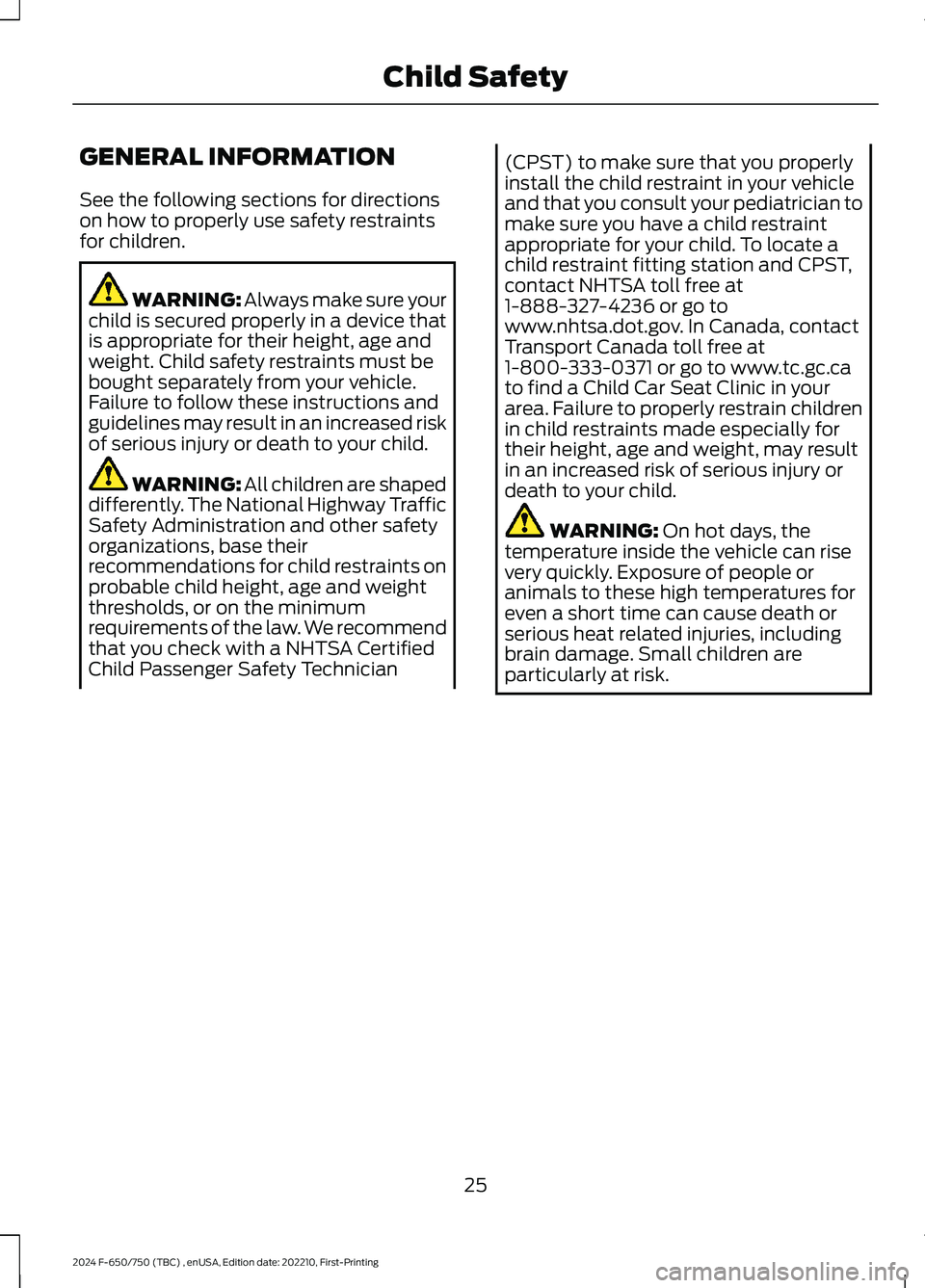
GENERAL INFORMATION
See the following sections for directionson how to properly use safety restraintsfor children.
WARNING: Always make sure yourchild is secured properly in a device thatis appropriate for their height, age andweight. Child safety restraints must bebought separately from your vehicle.Failure to follow these instructions andguidelines may result in an increased riskof serious injury or death to your child.
WARNING: All children are shapeddifferently. The National Highway TrafficSafety Administration and other safetyorganizations, base theirrecommendations for child restraints onprobable child height, age and weightthresholds, or on the minimumrequirements of the law. We recommendthat you check with a NHTSA CertifiedChild Passenger Safety Technician
(CPST) to make sure that you properlyinstall the child restraint in your vehicleand that you consult your pediatrician tomake sure you have a child restraintappropriate for your child. To locate achild restraint fitting station and CPST,contact NHTSA toll free at1-888-327-4236 or go towww.nhtsa.dot.gov. In Canada, contactTransport Canada toll free at1-800-333-0371 or go to www.tc.gc.cato find a Child Car Seat Clinic in yourarea. Failure to properly restrain childrenin child restraints made especially fortheir height, age and weight, may resultin an increased risk of serious injury ordeath to your child.
WARNING: On hot days, thetemperature inside the vehicle can risevery quickly. Exposure of people oranimals to these high temperatures foreven a short time can cause death orserious heat related injuries, includingbrain damage. Small children areparticularly at risk.
25
2024 F-650/750 (TBC) , enUSA, Edition date: 202210, First-PrintingChild Safety
Page 31 of 386

INSTALLING CHILD
RESTRAINTS
Child Restraints
Use a child restraint, sometimes called aninfant carrier, convertible seat, or toddlerseat, for infants, toddlers, or childrenweighing 40 lb (18 kg) or less (generallyage four or younger).
Using Seatbelts
WARNING: Do not place arearward facing child restraint in front ofan active airbag. Failure to follow thisinstruction could result in personal injuryor death.
WARNING: Properly securechildren 12 years old and under in a rearseating position whenever possible. Ifyou are unable to properly secure allchildren in a rear seating position,properly secure the largest child on thefront seat. If you must use a forwardfacing child restraint on the front seat,move the seat as far back as possible.Failure to follow these instructions couldresult in personal injury or death.
WARNING: Depending on whereyou secure a child restraint, anddepending on the child restraint design,you may block access to certain seatbeltbuckle assemblies and LATCH loweranchors, rendering those featurespotentially unusable. To avoid risk ofinjury, make sure occupants only useseating positions where they are able tobe properly restrained.
When installing a child restraint withseatbelts:
•Use the correct seatbelt buckle for thatseating position.
•Insert the belt tongue into the properbuckle until the latch engages. Makesure the tongue is securely fastened inthe buckle.
•Keep the buckle release buttonpointing up and away from the childrestraint, with the tongue between thechild restraint and the release button,to prevent accidental unbuckling.
•Place the vehicle seat in the uprightposition before you install the childrestraint.
•This vehicle does not require the useof a locking clip.
Perform the following steps wheninstalling the child restraint with seatbelts:
Note:Although the child restraintillustrated is a forward facing child restraint,the steps are the same for installing a rearfacing child restraint.
27
2024 F-650/750 (TBC) , enUSA, Edition date: 202210, First-PrintingChild SafetyE142594
Page 32 of 386
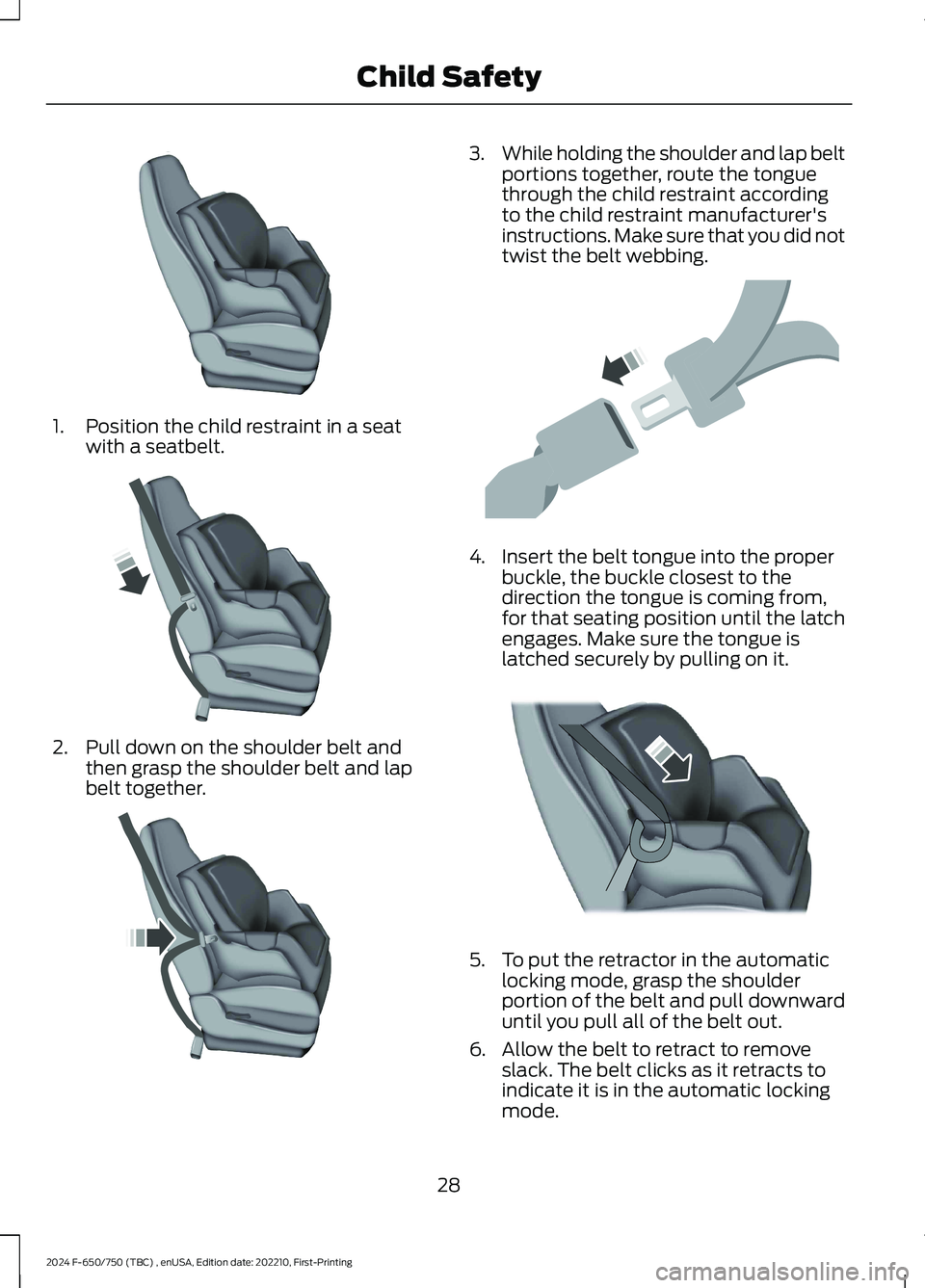
1.Position the child restraint in a seatwith a seatbelt.
2.Pull down on the shoulder belt andthen grasp the shoulder belt and lapbelt together.
3.While holding the shoulder and lap beltportions together, route the tonguethrough the child restraint accordingto the child restraint manufacturer'sinstructions. Make sure that you did nottwist the belt webbing.
4.Insert the belt tongue into the properbuckle, the buckle closest to thedirection the tongue is coming from,for that seating position until the latchengages. Make sure the tongue islatched securely by pulling on it.
5.To put the retractor in the automaticlocking mode, grasp the shoulderportion of the belt and pull downwarduntil you pull all of the belt out.
6.Allow the belt to retract to removeslack. The belt clicks as it retracts toindicate it is in the automatic lockingmode.
28
2024 F-650/750 (TBC) , enUSA, Edition date: 202210, First-PrintingChild SafetyE142528 E142529 E142530 E142531 E142875
Page 33 of 386
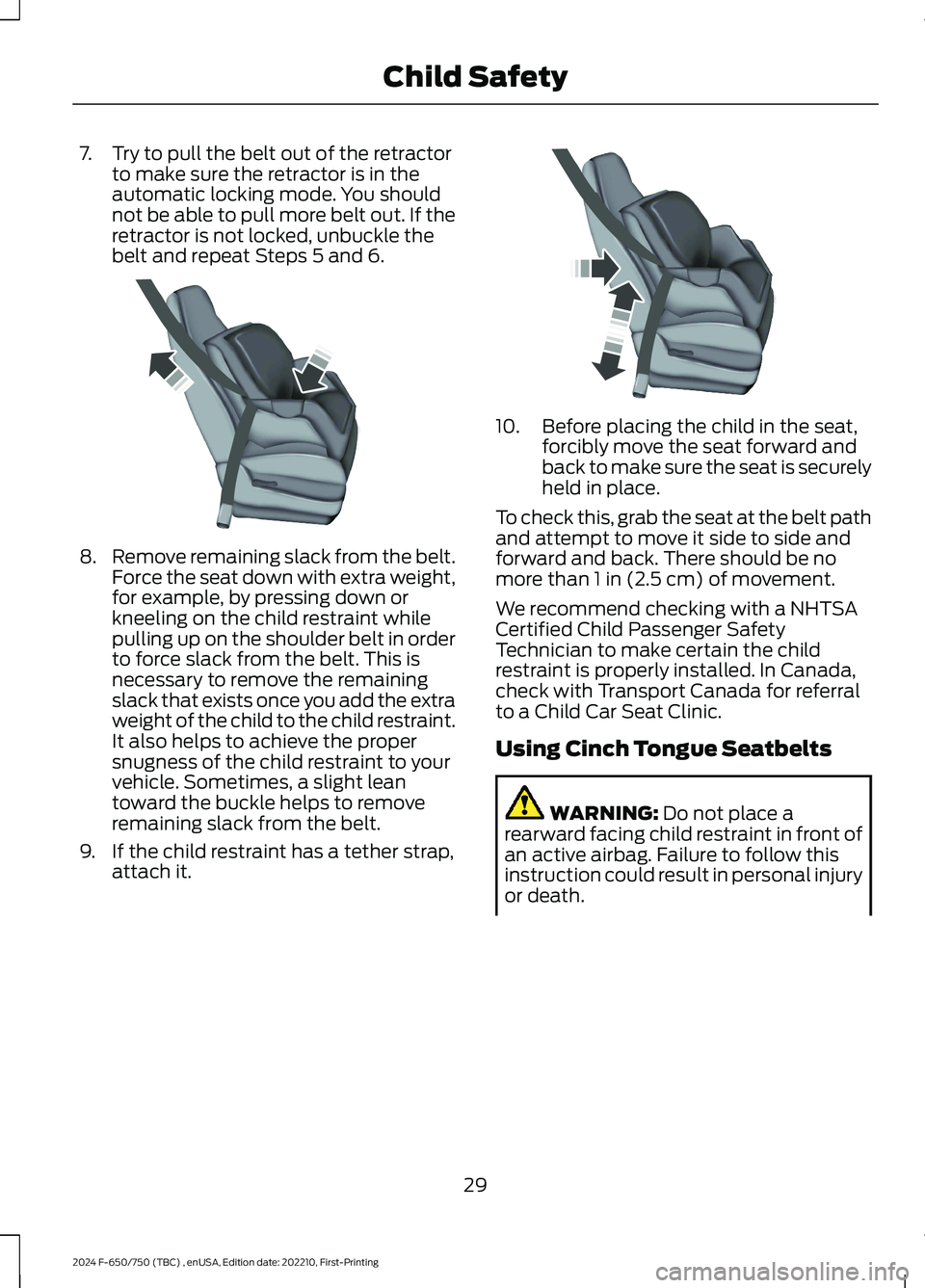
7.Try to pull the belt out of the retractorto make sure the retractor is in theautomatic locking mode. You shouldnot be able to pull more belt out. If theretractor is not locked, unbuckle thebelt and repeat Steps 5 and 6.
8.Remove remaining slack from the belt.Force the seat down with extra weight,for example, by pressing down orkneeling on the child restraint whilepulling up on the shoulder belt in orderto force slack from the belt. This isnecessary to remove the remainingslack that exists once you add the extraweight of the child to the child restraint.It also helps to achieve the propersnugness of the child restraint to yourvehicle. Sometimes, a slight leantoward the buckle helps to removeremaining slack from the belt.
9.If the child restraint has a tether strap,attach it.
10.Before placing the child in the seat,forcibly move the seat forward andback to make sure the seat is securelyheld in place.
To check this, grab the seat at the belt pathand attempt to move it side to side andforward and back. There should be nomore than 1 in (2.5 cm) of movement.
We recommend checking with a NHTSACertified Child Passenger SafetyTechnician to make certain the childrestraint is properly installed. In Canada,check with Transport Canada for referralto a Child Car Seat Clinic.
Using Cinch Tongue Seatbelts
WARNING: Do not place arearward facing child restraint in front ofan active airbag. Failure to follow thisinstruction could result in personal injuryor death.
29
2024 F-650/750 (TBC) , enUSA, Edition date: 202210, First-PrintingChild SafetyE142533 E142534
Page 34 of 386
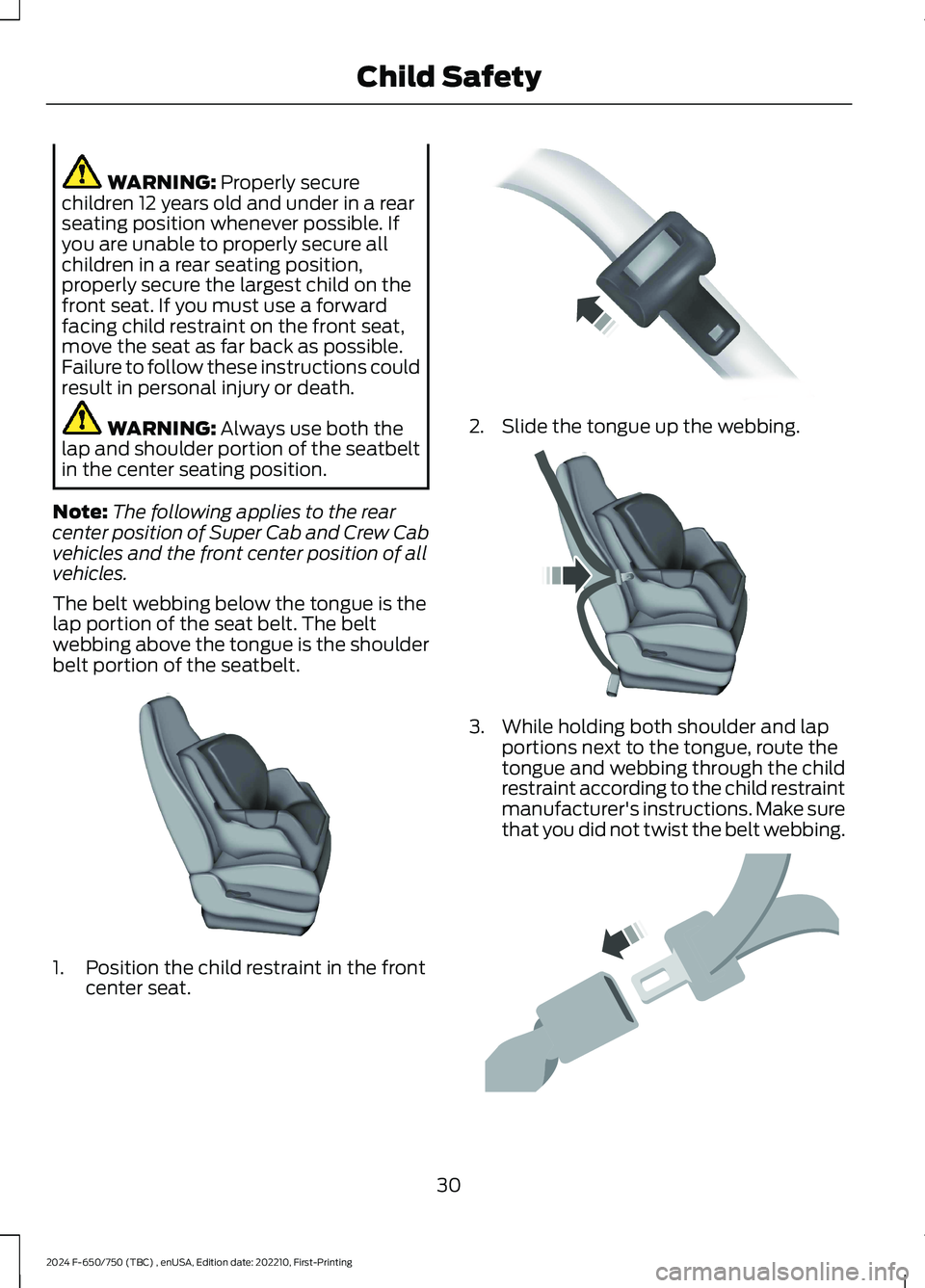
WARNING: Properly securechildren 12 years old and under in a rearseating position whenever possible. Ifyou are unable to properly secure allchildren in a rear seating position,properly secure the largest child on thefront seat. If you must use a forwardfacing child restraint on the front seat,move the seat as far back as possible.Failure to follow these instructions couldresult in personal injury or death.
WARNING: Always use both thelap and shoulder portion of the seatbeltin the center seating position.
Note:The following applies to the rearcenter position of Super Cab and Crew Cabvehicles and the front center position of allvehicles.
The belt webbing below the tongue is thelap portion of the seat belt. The beltwebbing above the tongue is the shoulderbelt portion of the seatbelt.
1.Position the child restraint in the frontcenter seat.
2.Slide the tongue up the webbing.
3.While holding both shoulder and lapportions next to the tongue, route thetongue and webbing through the childrestraint according to the child restraintmanufacturer's instructions. Make surethat you did not twist the belt webbing.
30
2024 F-650/750 (TBC) , enUSA, Edition date: 202210, First-PrintingChild SafetyE142528 E162708 E142530 E142531
Page 35 of 386
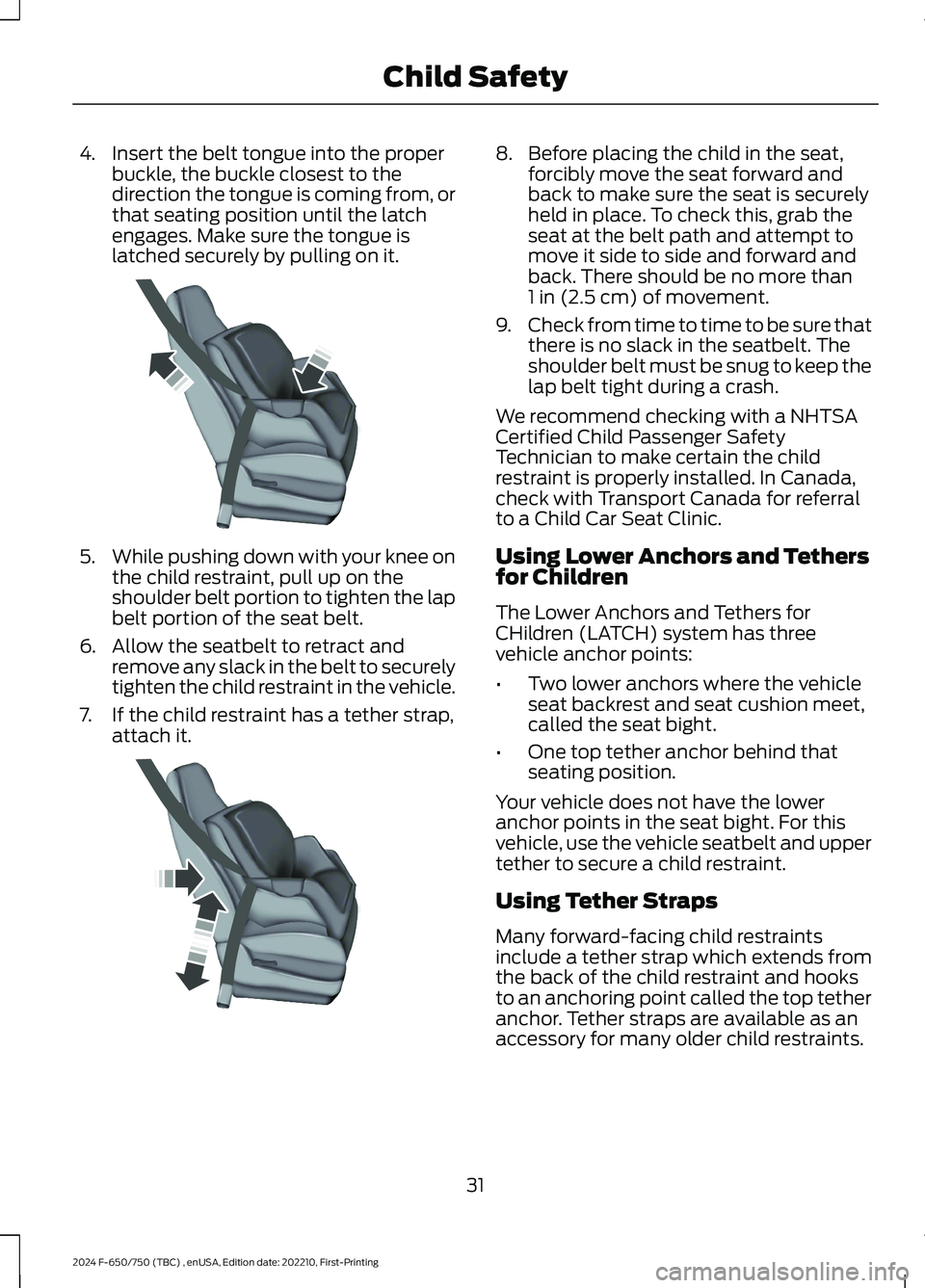
4.Insert the belt tongue into the properbuckle, the buckle closest to thedirection the tongue is coming from, orthat seating position until the latchengages. Make sure the tongue islatched securely by pulling on it.
5.While pushing down with your knee onthe child restraint, pull up on theshoulder belt portion to tighten the lapbelt portion of the seat belt.
6.Allow the seatbelt to retract andremove any slack in the belt to securelytighten the child restraint in the vehicle.
7.If the child restraint has a tether strap,attach it.
8.Before placing the child in the seat,forcibly move the seat forward andback to make sure the seat is securelyheld in place. To check this, grab theseat at the belt path and attempt tomove it side to side and forward andback. There should be no more than1 in (2.5 cm) of movement.
9.Check from time to time to be sure thatthere is no slack in the seatbelt. Theshoulder belt must be snug to keep thelap belt tight during a crash.
We recommend checking with a NHTSACertified Child Passenger SafetyTechnician to make certain the childrestraint is properly installed. In Canada,check with Transport Canada for referralto a Child Car Seat Clinic.
Using Lower Anchors and Tethersfor Children
The Lower Anchors and Tethers forCHildren (LATCH) system has threevehicle anchor points:
•Two lower anchors where the vehicleseat backrest and seat cushion meet,called the seat bight.
•One top tether anchor behind thatseating position.
Your vehicle does not have the loweranchor points in the seat bight. For thisvehicle, use the vehicle seatbelt and uppertether to secure a child restraint.
Using Tether Straps
Many forward-facing child restraintsinclude a tether strap which extends fromthe back of the child restraint and hooksto an anchoring point called the top tetheranchor. Tether straps are available as anaccessory for many older child restraints.
31
2024 F-650/750 (TBC) , enUSA, Edition date: 202210, First-PrintingChild SafetyE142533 E142534
Page 43 of 386

•Height adjuster at the front outboardseating positions.
•Safety belt pretensioner at the frontoutboard seating positions.
•Safety belt warning light and chime.
FASTENING THE SEATBELTS
The front outboard and rear safetyrestraints in the vehicle are combinationlap and shoulder belts.
1.Insert the belt tongue into the properbuckle (the buckle closest to thedirection the tongue is coming from)until you hear a snap and feel it latch.Make sure you securely fasten thetongue in the buckle.
2.To unfasten, press the release buttonand remove the tongue from thebuckle.
Using the Seatbelt with CinchTongue (Front Center and RearCenter Seats Only)
The cinch tongue slides up and down thebelt webbing when the belt is stowed orwhile putting seatbelts on. When the lapand shoulder seatbelt is buckled, the cinchtongue allows the lap portion to beshortened, but pinches the webbing tokeep the lap portion from getting longer.The cinch tongue is designed to slip duringa crash, so always wear the shoulder beltproperly and do not allow any slack ineither the lap or shoulder portions.
Before you can reach and latch a lap andshoulder belt having a cinch tongue intothe buckle, you may have to lengthen thelap belt portion of it.
1.To lengthen the lap belt, pull somewebbing out of the shoulder beltretractor.
2.While holding the webbing below thetongue, grasp the tip (metal portion)of the tongue so that it is parallel to thewebbing and slide the tongue upward.
3.Provide enough lap belt length so thatthe tongue can reach the buckle.
39
2024 F-650/750 (TBC) , enUSA, Edition date: 202210, First-PrintingSeatbeltsE71880 E142587 E142588 E162708
Page 44 of 386

Fastening the Cinch Tongue
WARNING: Always drive and ridewith your seatback upright and the lapbelt snug and low across the hips.
1.Pull the lap and shoulder belt from theretractor so that the shoulder beltportion of the seatbelt crosses yourshoulder and chest.
2.Be sure the belt is not twisted. If thebelt is twisted, remove the twist.
3.Insert the belt tongue into the properbuckle for your seating position untilyou hear a snap and feel it latch.
4.Make sure the tongue is securelyfastened to the buckle by pulling onthe tongue.
While you are fastened in the seatbelt, thelap and shoulder belt with a cinch tongueadjusts to your movement. However, if youbrake hard, turn hard, or if your vehiclereceives an impact of 5 mph (8 km/h) ormore, the seatbelt will become locked andhelp reduce your forward movement.
Lap Belts
WARNING: Always drive and ridewith your seatback upright and the lapbelt snug and low across the hips.
The front center lap belt does not adjustautomatically.
Insert the tongue into the correct buckle(the buckle closest to the direction thetongue is coming from). To lengthen thebelt, turn the tongue at a right angle to thebelt and pull across your lap until it reachesthe buckle. To tighten the belt, pull theloose end of the belt through the tongueuntil it fits snugly across the hips.
Shorten and fasten the belt when not inuse.
40
2024 F-650/750 (TBC) , enUSA, Edition date: 202210, First-PrintingSeatbeltsE208768 E208769